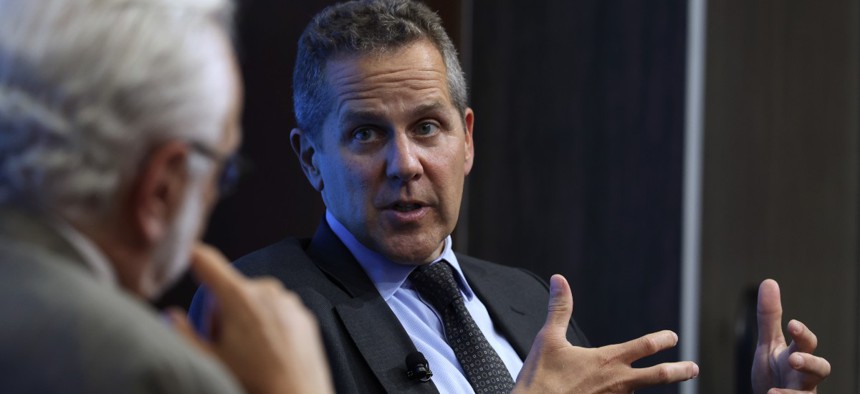Many Digital Assets are ‘Rife With Risks,’ Fed Official Warns

Federal Reserve Vice Chair Michael Barr speaks during an event at the Brookings Institution on September 7, 2022 in Washington, DC. Alex Wong/Getty Images
The Federal Reserve underscored the volatility that comes with digital currencies while speaking to the agency’s other modernization efforts.
The Federal Reserve remains wary of cryptocurrencies and digital assets in the traditional financial system as the agency continues to modernize its service offerings.
Speaking during FinTech Week at Georgetown University, Fed Vice Chairman Michael Barr delivered remarks on the current approach to regulations within the Federal Reserve, emphasizing the need to strike a balance between a functioning free market economy and federal consumer protections.
"To realize the benefits of innovation, we need to manage relevant risks," he said.
Barr focused this balance on cryptocurrency regulation, a task the Biden administration has made prominent strides in since the president signed an executive order spurring federal investigation into the digital currency market.
Noting that cryptocurrency market capitalization and participation have grown in recent years, Barr noted that the unregulated asset class still poses financial risk to consumers and that some crypto assets are "rife with risks, including fraud, theft, manipulation and exposure to money laundering activities."
"Crypto asset-related activity both outside and inside supervised banks requires oversight that includes safeguards to ensure that crypto service providers are subject to similar regulations as other financial services providers," he said.
Barr added that the Federal Reserve Board is working alongside officials within the Office of the Comptroller of the Currency and the Federal Deposit Insurance Corporation to facilitate consumer protection during cryptocurrency banking activity.
While banks are responsible for ensuring their transactions involving cryptocurrency are legal and that they have measures in place to reduce financial crime, the volatility in the interconnected crypto market reveals the risks that banks could suffer if handling digital asset transactions.
"When a bank’s deposits are concentrated in deposits from a crypto asset industry, from crypto asset companies [that] are highly interconnected…banks may experience deposit fluctuations that are correlated and closely linked to broader developments in the crypto asset markets," Barr said. He added that both misrepresentation and lack of regulation on deposit insurance by crypto asset companies can lead to widespread consumer confusion, and potential bank runs.
"It is important for banks to understand some of the heightened liquidity risks they may face from certain types of deposits from crypto asset companies," Barr continued.
He pivoted to the seemingly preferred alternative at the Fed: stablecoins. Barr explained that stablecoins, which can be tied to a national currency, have a better operating capacity than their volatile, decentralized cryptocurrency counterparts.
"We have an abiding interest in a strong federal prudential framework for [stablecoin] use,” Barr said.
He explained that some banks have recently been exploring how to incorporate stablecoins into their operations. Proposals seen by the Fed include issuing stablecoin tokens along privately controlled networks and distributed ledger technology, or issuing these tokens on permissionless networks. He again underscored the need for forecasting risk and taking appropriate preventative actions.
"It remains an open question when banks can engage in such arrangements in a manner consistent with safe and sound banking," he said. He further advised that banks experimenting with stablecoin operations should only do so in a safe and legally permissible manner.
Beyond cryptocurrency and stablecoin regulation, the Fed has been modernizing other financial tools.
"We need to get the guardrails right to successfully support a dynamic marketplace of innovation, financial products and services," he said. "We have a responsibility to ensure that regulation and supervision foster innovations that improve access to financial services, while at the same time safeguarding consumers, financial institutions and financial stability."
Barr said that secure data sharing between banks and non-banks has been the backbone in developing an advanced, digital financial services sector. In partnership with private sector counterparts, the Fed has been working on revamping its payment system to move money quickly and safely.
Earlier this summer, fellow Fed Vice Chair Lael Brainard told lawmakers that updates to the agency's payment platform, FedNow, could help introduce a central bank digital currency, which is a digital currency that acts as a virtual extension of a national fiat.
"We are in the final stages of creating the FedNow service, a new platform for digital payments that will safely, efficiently, and instantaneously move money," he said. FedNow is expected to debut between May and June 2023.






